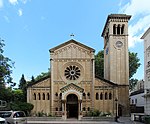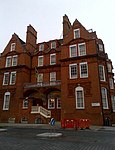Centre for Environmental Policy
Environmental research institutesEnvironmental studies institutions in the United KingdomImperial College Faculty of Natural SciencesResearch institutes of Imperial College LondonUnited Kingdom university stubs
The Centre for Environmental Policy (CEP) is a department at Imperial College London in the Faculty of Natural Sciences. Its aim is to influence a wide range of environmental issues through research on the environmental, energy and health aspects of global problems. CEP's current director is Professor Mark Burgman.
Excerpt from the Wikipedia article Centre for Environmental Policy (License: CC BY-SA 3.0, Authors).Centre for Environmental Policy
Exhibition Road, City of Westminster Brompton (Royal Borough of Kensington and Chelsea)
Geographical coordinates (GPS) Address Website Nearby Places Show on map
Geographical coordinates (GPS)
| Latitude | Longitude |
|---|---|
| N 51.500177 ° | E -0.171948 ° |
Address
Imperial College London (Imperial College)
Exhibition Road
SW7 2AZ City of Westminster, Brompton (Royal Borough of Kensington and Chelsea)
England, United Kingdom
Open on Google Maps











